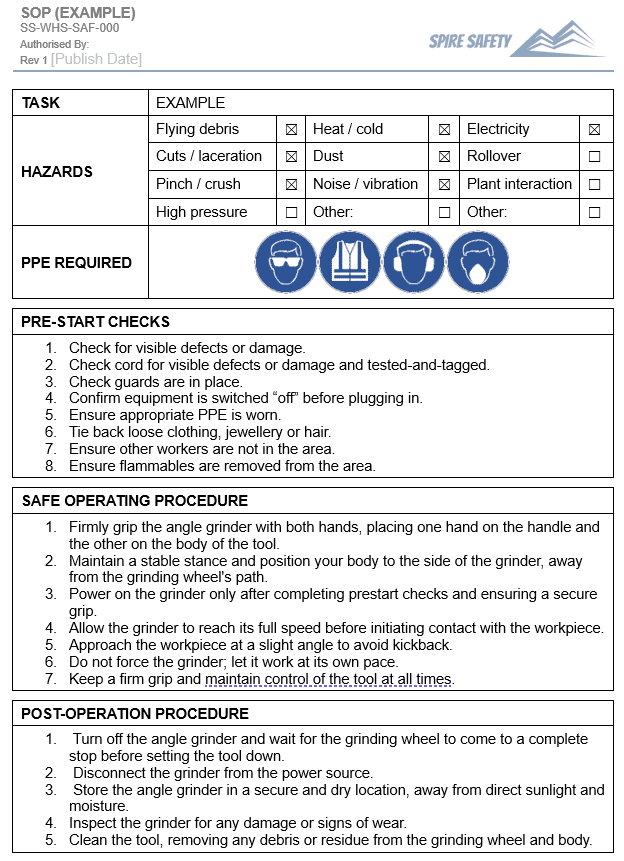FREE Extension Ladder SOP (Safe Operating Procedure) Template
Download our free Extension Ladder SOP Template:
*For internal use only. Not for resale or redistribution. By downloading, you agree to our Free Resources Licensing Agreement.

Purpose of an Extension Ladder SOP
Extension ladder SOPs outline a safe operating procedure for extension ladder use. The SOP can also be used as a training and induction document. The primary goal is to protect workers from injury or illness by outlining a safe system of work and providing adequate training and instruction. This form is broadly aligned with AS45001:2018.
How to Use
Extension ladder SOPs should be communicated to workers before they complete the task. A hard copy can also be displayed in the workplace or provided at the workface. You can also use extension ladder SOPs during the induction or onboarding process.
NOTE: This document is a template only and it must be customised for your business. Other aspects that need to be considered include, but are not limited to, ensuring that:
- Relevant legal requirements have been met,
- Workplace specific risks are identified and management, and
- Workers are consulted with during the customisation / review process.
When to Use
Workers should read and agree to comply with extension ladder SOPs prior to operation within your business. They can also be used for refresher training periodically.
Who Should Use
Extension ladder SOPs should be developed by a competent person. The SOP is then read and followed by the worker completing the task. New workers should also read and understand the SOPs during the induction or onboarding process.
Legal Considerations
There is no specific legal requirement to have a documented Safe Operating Procedure (SOP). However, it is best practice, as having SOPs can assist in meeting general legal duties, including:
- s(19)(3)c WHS Act – Duty to Provide Safe Systems of Work
- s(19)(3)d WHS Act – Duty to Ensure Safe Use of Plant
- s(19)(3)f WHS Act – Duty to Provide Adequate Information, Training, Instruction and Supervision
- s(39) WHS Regulations – Duty to Provide Adequate Information, Training and Instruction
- s(203) WHS Regulations – Management of Risks to Health and Safety (PCBUs with management or control of plant)
The Code of Practice “Managing risks of plant in the workplace” states that employers (PCBUs) must provide workers with information, training, and instruction as necessary to protect them from risks arising from the use of the plant.
FAQ’s
What is an extension ladder?
Extension ladders are adjustable in length ladders that consist of two or more sections that travel in guides or brackets so they can be extended to a desired height.
What is an extension ladder used for?
Extension ladders are valued for their reach and adaptability, allowing one ladder to serve multiple purposes across different heights and work scenarios.
What hazards are involved in extension ladder use?
Some hazards that are involved in extension ladder use include:
- Overreaching
- Slipping
- Falling
- Collapsing
What are some safety controls that can be utilised during extension ladder use?
Some safety controls that can be utilised include:
- Secure footing
- Proper setup
- Rope and pulley systems
- Wearing PPE
Did you know?
Extension ladders bear witness to how essential vertical mobility is across countless industries, with their telescoping design representing a blend of simplicity and mechanical sophistication. They often come with safety features such as no-slip feet, self-locking mechanisms for the rungs, and rope and pulley systems that enable easy and safe adjustments from the ground. Innovations in ladder design have also seen the incorporation of lightweight yet strong materials like fiberglass, which besides being durable, also provides electrical insulation, making these ladders safer for electrical work.
Article Sources and Further Reading
- Model Code of Practice: Managing risks of plant in the workplace (Safe Work Australia) <https://www.safeworkaustralia.gov.au/doc/model-code-practice-managing-risks-plant-workplace>
- Plant (Safe Work Australia) <https://www.safeworkaustralia.gov.au/safety-topic/managing-health-and-safety/plant>
- The Complete Guide to WHS Policies and Procedures in Australia (Spire Safety) <https://spiresafety.com.au/resources/guide-to-whs-policies-and-procedures/>
- What is a PCBU? (Spire Safety) <https://spiresafety.com.au/resources/what-is-a-pcbu/>
